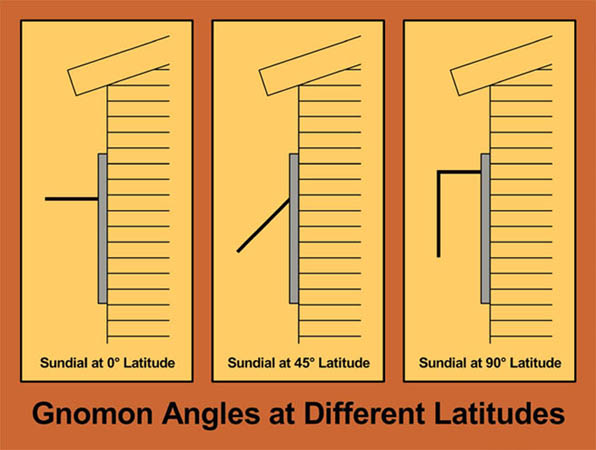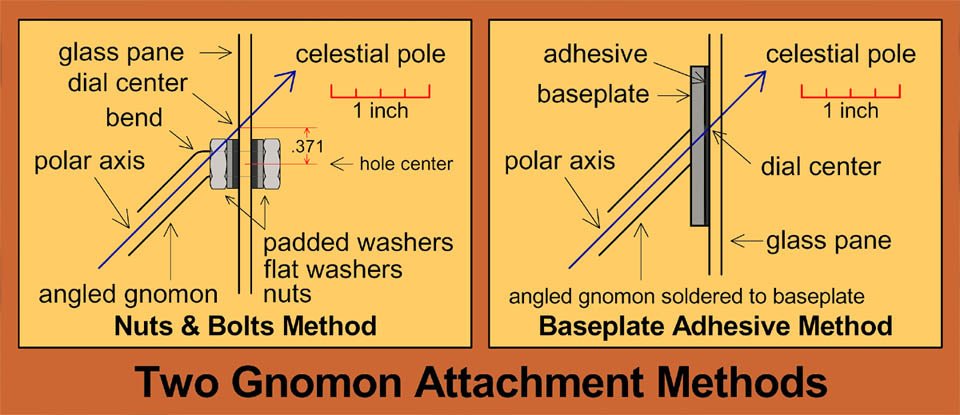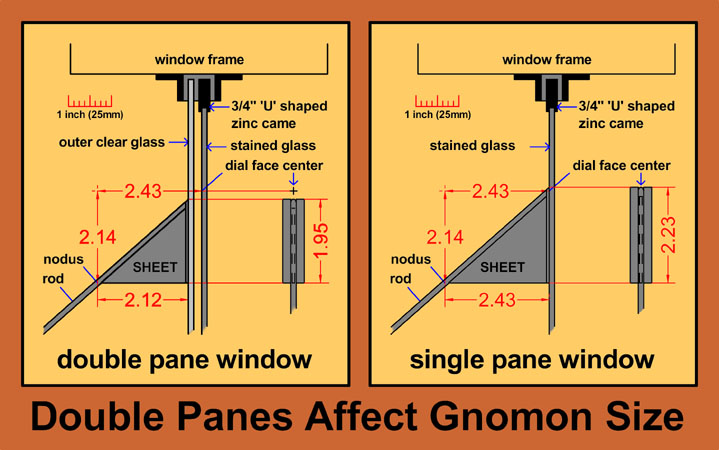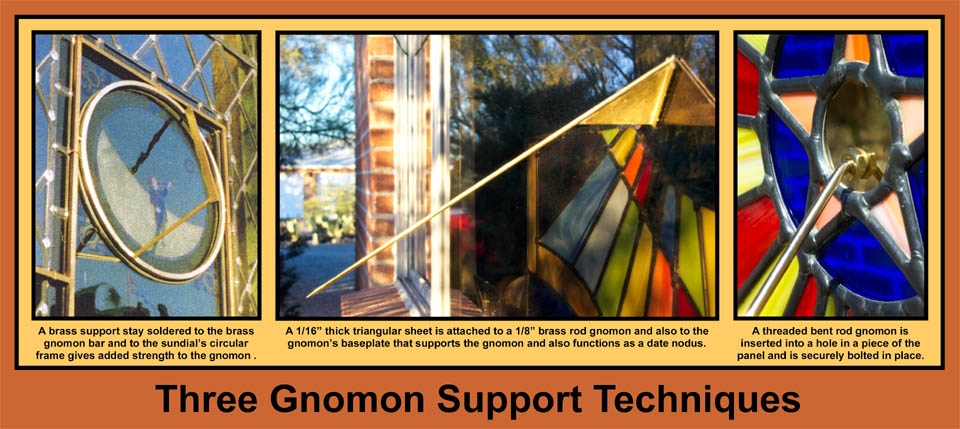

 |
All linear gnomons, properly positioned on any sundial, will be parallel to the Earth's axis, and will point to both the North and South Celestial Poles. The North Celestial Pole is located very near the North Star. So, on South wall windows in the Northern Hemisphere, the gnomon will extend outwards and from the dial face and will be angled downwards to the South at mid-latitudes. At the Equator, it would extend horizontally at a right angle to the window face, and at either Pole, it would be parallel to the window, vertical, and spaced away from it. The gnomon's length and width depend on the sundial's size and latitude and must be mathematically determined by the designer. The gnomon will cast a long shadow in the summer when the sun is high in the sky and a short shadow in the winter when the sun is closer to the horizon. If the gnomon is too short, its shadow won't reach the hour marks in the winter. The gnomon's length should be long enough to cast a shadow on the sundial's hour marks on the winter solstice. Also, the gnomon's width should be wide enough to cast a readable shadow. If the gnomon is too thin, its shadow will be thin, fuzzy and hard to read. Larger sundials require longer and thicker gnomons. |
There are several places and ways that you can attach the gnomon. Depending on your design requirements, you can attach it directly to the glass or to the lead came strips or even to the window frame or building's wall. You can drill holes for nut and bolt attachment, or you can solder, weld or use an adhesive. Modern adhesives such as silicone and some of the epoxies are a great alternative to drilling unwanted holes or soldering, and are ideal for temporary test sundials but may not last as long or be as strong as soldering or bolting.
Nuts and bolts attachment is the traditional method. Make screw threads on the end of the metal rod gnomon and bend it in a vise to the exact angle specified in the design plans. Place it through a slightly larger hole cut in the glass or metal structure of the window. To cut a hole through glass, use a Dremel-type moto-tool at high speed with a sphere-shaped diamond burr lubricated with water. If the hole is through glass, to protect the glass, you should use padded washers between the glass and flat metal washers. You might even put a thin padded sleeve around the gnomon so that it is not in contact with the glass at all. Tighten this "sandwich" with nuts on both sides, making sure that the gnomon is pointing in the right direction. Of course, if the glass is too thin, the gnomon could crack the glass, so the other methods of attachment would be preferable. But if the glass is at least 3mm (1/8 inch) thick, it should be ok to bolt the gnomon directly to it if it isn't too heavy.
Note that if the gnomon is angled downward, the hole in the glass is slightly below the center of the sundial on the outside of the glass where the hour lines converge. (see Rod Gnomon Attachment Detail drawing). The distance between the hole and the dial center is variable depending on angle of the gnomon and its thickness. In this example, a 45 degree, 1/4 inch thick gnomon makes the distance between the hole and the dial center equal to .371 inches. This distance increases if the gnomon's width increases or if the gnomon is bent more. Therefore, at higher latitudes, the distance from the hole to the dial center increases.
 |
Most new and restored stained glass windows have isothermal glazing which is a pane of clear ordinary window glass on the exterior side of the stained glass to protect them from the weather, hard impacts, soiling and to insulate the building. A protective outer pane of glass will also help prevent heating of the lead came and will decrease sagging and bowing. Some building codes even require them. If you want a protective window in front of the stained glass, you can attach the gnomon to the exterior side of the protective window using silicone adhesive or nuts and bolts. If you do this, it is important to consider the thickness of the protective glass and its distance from the surface of the stained glass when designing the height of the gnomon. If the gnomon is elevated above the sundial face then you must decrease the height of the gnomon by an amount that is equal to this distance otherwise it will be too tall and the time and date readings won't be precise. This is especially important if the dial is small. If you attach the gnomon directly to the stained glass and the shadow receiving surface is factory-made opalescent glass, then no gnomon height adjustment is necessary, since shadows are always cast on the outside of opaque glass. But if the shadow receiving surface is painted on the inside of clear glass, then you must decrease the gnomon height by an amount equal to the glass thickness. Don't worry about the minor distortion effects of the shadow's light refraction through the glass unless the sundial is very small or the glass is very thick.
 |
Install the stained glass panel from the inside so that there is a small air space between the outer protective glazing and the stained glass. The recommended airspace width is 3/4" (19mm), but can be narrower if desired. As an example, if the glass is 1/8 inch thick and the air space is 1/4 inch, then you must decrease the gnomon height by 3/8 inch. In this graphic, the air space between the panes is a little less than 1/4". Notice how a double pane window calls for a smaller gnomon. Note: To avoid overheating, condensation, and mold between the inner and outer panes, keep their separation distance to a minimum and do not tightly seal with caulking the space between the stained glass window and the protective outer pane so that the dead air space can breathe. Also, never sandwich the stained glass panel between two panes of glass unless the space between is ventilated. You may put the stained glass panel on the room side of a double or triple pane isothermal hermetically sealed window. |

A rod gnomon attached by a loose nut could easily swivel and become out of alignment and affect the sundial's performance. To prevent this, you can give it added support by soldering a metal support stay to the outside frame of the window and to the tip of the gnomon or you can attach the gnomon and/or the support stay to the building's wall if it is practical instead of to the window or the window frame.
A rod gnomon soldered to a sheet that's firmly attached to the face at least two points is another good way to support and stabilize the rod and may also co-function as a nodus for telling the date. You can solder a flat baseplate to a sheet or rod and sheet gnomon and then solder or use an adhesive to attach the baseplate to the lead came or glass. Your sundial designer will surely help you with the design and placement of the all-important gnomon.
|